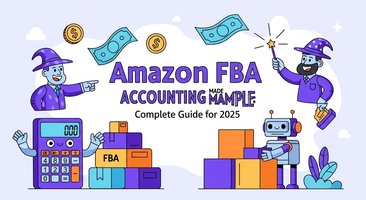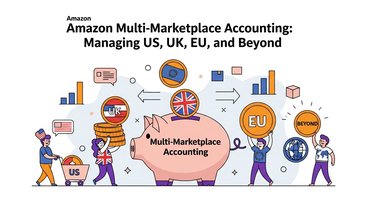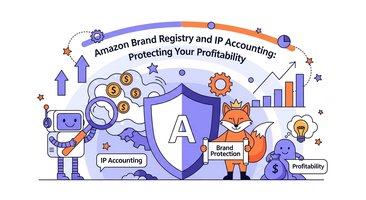Choosing between Amazon wholesale and private label represents one of the most critical strategic decisions for Amazon sellers. Each model offers distinct advantages and challenges, with dramatically different profitability profiles, capital requirements, and accounting complexities that can make or break your business success.
This comprehensive analysis will help you understand the financial implications of each model, compare their profitability potential, and make informed decisions about which approach aligns best with your business goals and resources.
Understanding the Two Business Models
The fundamental difference between wholesale and private label lies in product ownership, brand control, and market positioning, creating cascading effects throughout your entire business operation and financial structure.
Amazon Wholesale Model Overview
Wholesale selling involves purchasing existing branded products from manufacturers or distributors and reselling them on Amazon without modification. You're essentially acting as a retailer for established brands.
Key characteristics of wholesale:
- Sell existing branded products
- Compete with other sellers of the same products
- Limited control over product features or packaging
- Established market demand and recognition
- Lower barriers to entry
- Faster time to market
Private Label Model Overview
Private label selling involves creating your own branded products, typically by working with manufacturers to produce items under your brand name. You control the entire product experience from design to customer service.
Key characteristics of private label:
- Create unique branded products
- Own exclusive rights to your products
- Complete control over product design and features
- Build brand recognition from scratch
- Higher barriers to entry
- Longer development timelines
Financial Structure Comparison
The financial structures of wholesale and private label businesses differ significantly, affecting everything from startup costs to ongoing profitability and cash flow management.
Initial Investment Requirements
Startup capital needs vary dramatically between the two models:
Wholesale Initial Investment:
- Product sourcing: $5,000-$50,000 typical range
- Inventory purchases at wholesale prices
- Immediate product availability
- Lower minimum order quantities
- Established supplier relationships available
Private Label Initial Investment:
- Product development: $10,000-$100,000+ typical range
- Minimum order quantities often higher
- Tooling and setup costs
- Brand development and trademark registration
- Extended timeline before revenue generation
Ongoing Capital Requirements
Working capital needs differ significantly between models:
Wholesale Working Capital:
- Inventory replenishment at established wholesale prices
- Predictable cost structures
- Seasonal demand variations
- Competitive pricing pressures
- Limited control over supplier terms
Private Label Working Capital:
- Larger inventory commitments due to MOQs
- Product development and improvement costs
- Marketing and brand building investments
- Quality control and testing expenses
- Packaging and compliance costs
Revenue and Margin Analysis
Profitability potential varies significantly between wholesale and private label, with different factors driving success in each model.
Wholesale Profit Margins
Wholesale margins are typically lower but more predictable:
Typical Margin Ranges:
- Gross margins: 15-40% depending on category and competition
- Net margins: 5-15% after all Amazon fees and expenses
- Higher volume potential but lower per-unit profits
- Margin compression from competition
Margin Influencing Factors:
- Number of competing sellers
- Brand popularity and demand
- Seasonal variations
- Supplier pricing changes
- Amazon fee structure changes
Private Label Profit Margins
Private label margins offer higher potential but with greater variability:
Typical Margin Ranges:
- Gross margins: 40-70% with successful products
- Net margins: 15-35% after all costs and investments
- Higher per-unit profits but potentially lower volumes initially
- Greater control over pricing strategies
Margin Influencing Factors:
- Product differentiation and uniqueness
- Brand recognition and customer loyalty
- Manufacturing efficiency and scale
- Marketing effectiveness
- Competitive landscape development
Cost Structure Analysis
Understanding the complete cost structure of each model helps identify the true profitability potential and break-even requirements.
Wholesale Cost Components
Wholesale cost structure includes several key elements:
Product Costs:
- Wholesale purchase price (typically 50-70% of retail)
- Shipping from supplier to Amazon
- Potential minimum order requirements
- Volume discount opportunities
Amazon Fees:
- Referral fees (6-15% depending on category)
- FBA fulfillment fees
- Storage fees
- Advertising costs for competitive visibility
Operating Expenses:
- Sourcing and research time
- Inventory management systems
- Competitive analysis tools
- Customer service (though limited for wholesale)
Private Label Cost Components
Private label cost structure involves more complex cost categories:
Product Development Costs:
- Initial product design and prototyping
- Manufacturing setup and tooling
- Quality testing and compliance
- Packaging design and development
Manufacturing Costs:
- Per-unit manufacturing costs (typically 20-40% of retail)
- International shipping and customs
- Quality control and inspection
- Inventory management and storage
Brand Building Costs:
- Trademark registration and IP protection
- Professional photography and content creation
- Enhanced brand content and A+ pages
- Marketing and advertising campaigns
Ongoing Operational Costs:
- Product improvements and variations
- Customer service and support
- Inventory forecasting and management
- Compliance and regulatory requirements
Risk Assessment and Management
Risk profiles differ significantly between wholesale and private label, affecting both potential returns and business sustainability.
Wholesale Risk Factors
Wholesale risks tend to be more immediate but potentially less severe:
Market Risks:
- Increased competition from other sellers
- Brand owner restrictions or termination
- Price wars and margin compression
- Seasonal demand fluctuations
Operational Risks:
- Supplier relationship changes
- Inventory availability issues
- Account health problems from competition
- Limited differentiation opportunities
Financial Risks:
- Lower margins provide less buffer for mistakes
- Dependency on external brand performance
- Limited control over pricing strategies
- Potential for rapid market changes
Private Label Risk Factors
Private label risks are often longer-term but potentially more severe:
Development Risks:
- Product development failures
- Manufacturing quality issues
- Regulatory compliance problems
- Intellectual property disputes
Market Risks:
- Product launch failures
- Brand building challenges
- Customer acceptance issues
- Competitive response to successful products
Financial Risks:
- Higher upfront investments at risk
- Longer payback periods
- Inventory obsolescence potential
- Marketing investment requirements
Accounting and Financial Management Differences
Accounting complexity varies significantly between the two models, affecting both ongoing management requirements and financial reporting needs.
Wholesale Accounting Considerations
Wholesale accounting follows traditional retail patterns with some Amazon-specific complexities:
Inventory Management:
- Straightforward purchase and resale model
- Established cost basis from wholesale purchases
- Standard inventory valuation methods (FIFO, LIFO, weighted average)
- Predictable cost of goods sold calculations
Revenue Recognition:
- Simple point-of-sale revenue recognition
- Straightforward return and refund processing
- Clear attribution of sales to specific products
- Standard retail accounting practices apply
Cost Tracking:
- Direct product costs easily identifiable
- Amazon fees apply standard categorization
- Limited complexity in cost allocation
- Straightforward profitability analysis
Private Label Accounting Considerations
Private label accounting involves significantly more complexity:
Product Development Costs:
- Capitalization vs expensing decisions
- Amortization of development costs
- Allocation across product variations
- R&D expense tracking and optimization
Manufacturing Cost Allocation:
- Landed cost calculations including duties and shipping
- Quality control and testing cost allocation
- Packaging and compliance cost tracking
- MOQ impact on per-unit costs
Brand Investment Tracking:
- Marketing cost allocation across products
- Brand building ROI measurement
- IP protection cost amortization
- Long-term brand value considerations
Performance Measurement and Analytics
Success metrics differ between wholesale and private label, requiring different analytical approaches and performance monitoring systems.
Wholesale Performance Metrics
Key wholesale metrics focus on efficiency and market positioning:
Financial Metrics:
- Gross margin percentage
- Inventory turnover rates
- Return on investment (ROI)
- Cash conversion cycle
Operational Metrics:
- Sales velocity and ranking
- Market share within product categories
- Supplier relationship quality
- Inventory accuracy and availability
Competitive Metrics:
- Price positioning relative to competitors
- Buy Box win percentage
- Review ratings and quantities
- Search ranking performance
Private Label Performance Metrics
Private label metrics emphasize brand building and long-term value creation:
Financial Metrics:
- Customer lifetime value (CLV)
- Brand equity valuation
- Product development ROI
- Marketing efficiency ratios
Brand Metrics:
- Brand recognition and recall
- Customer loyalty and repeat purchase rates
- Premium pricing sustainability
- Cross-selling and upselling success
Product Metrics:
- Product differentiation effectiveness
- Innovation pipeline value
- Quality metrics and defect rates
- Product lifecycle management
Technology and Automation Considerations
Automation needs differ significantly between wholesale and private label operations, affecting both operational efficiency and accounting complexity.
Wholesale Automation Needs
Wholesale automation focuses on efficiency and competitive monitoring:
Inventory Management:
- Automated reordering based on sales velocity
- Supplier integration for real-time availability
- Competitive pricing monitoring and adjustment
- Seasonal demand forecasting
Financial Tracking:
- Standard ecommerce accounting automation
- Profitability analysis by product and supplier
- Cash flow management and forecasting
- Tax compliance and reporting
Private Label Automation Needs
Private label automation requires more sophisticated systems:
Product Development:
- Project management and cost tracking
- Quality control and testing documentation
- Supplier relationship management
- Compliance and regulatory tracking
Brand Management:
- Marketing campaign tracking and attribution
- Customer feedback analysis and response
- Brand mention monitoring and protection
- Content management and optimization
Klavena's Analytics Support
Klavena provides comprehensive analytics capabilities that support both business models:
Profitability Analysis: Compare profitability across different products, suppliers, and business models to identify the most successful strategies.
Cost Tracking: Monitor all cost components including product costs, Amazon fees, and operational expenses for accurate margin analysis.
Performance Monitoring: Track key metrics specific to your business model, whether wholesale efficiency or private label brand building.
Financial Reporting: Generate detailed reports that help evaluate the success of different business models and make informed strategic decisions.
Making the Strategic Choice
Choosing between wholesale and private label requires careful consideration of multiple factors beyond just profitability potential.
Choose Wholesale When:
Resource Constraints: Limited capital or time for product development makes wholesale more accessible.
Risk Tolerance: Preference for lower-risk, faster-return opportunities aligns with wholesale characteristics.
Market Knowledge: Strong understanding of existing products and supplier relationships provides competitive advantages.
Operational Preferences: Focus on efficiency and scale rather than brand building and product development.
Choose Private Label When:
Long-Term Vision: Commitment to building sustainable brand value and market differentiation.
Capital Availability: Sufficient resources to invest in product development, inventory, and brand building.
Control Preference: Desire for complete control over product features, pricing, and customer experience.
Innovation Focus: Interest in product development, market creation, and brand building activities.
Hybrid Approaches
Combined strategies can provide benefits of both models:
Portfolio Diversification: Operate both wholesale and private label products to balance risk and return.
Market Testing: Use wholesale to test market demand before developing private label alternatives.
Cash Flow Management: Use wholesale profits to fund private label development investments.
Skill Development: Build Amazon selling expertise with wholesale before tackling private label complexity.
Financial Projections and Modeling
Financial modeling helps evaluate the long-term profitability potential of each business model under different scenarios.
Wholesale Financial Projections
Wholesale projections focus on volume growth and margin sustainability:
Year 1-2 Projections:
- Rapid revenue growth potential
- Margin compression from competition
- Inventory investment scaling with sales
- Limited brand building investment needs
Long-Term Projections:
- Steady but potentially declining margins
- Volume-dependent profitability
- Limited differentiation opportunities
- Vulnerability to market changes
Private Label Financial Projections
Private label projections emphasize long-term brand value creation:
Year 1-3 Projections:
- Higher initial investment requirements
- Longer break-even periods
- Significant marketing and development costs
- Building brand recognition and market share
Long-Term Projections:
- Higher sustainable margins
- Brand equity value creation
- Market leadership opportunities
- Defensive competitive positioning
Conclusion
The choice between Amazon wholesale and private label depends on your specific situation, resources, and business objectives. Wholesale offers faster entry and lower risk but potentially limited long-term profitability. Private label requires higher investment and longer development periods but offers greater control and profit potential.
Financial success in either model requires understanding the complete cost structure, implementing proper accounting systems, and making data-driven decisions about resource allocation and strategic direction. The most successful sellers often develop expertise in one model before expanding to others or combining approaches strategically.
Klavena's profitability analysis capabilities provide the insights needed to evaluate both business models objectively, track performance accurately, and make informed decisions about strategic direction. Whether you choose wholesale, private label, or a hybrid approach, proper financial analysis and accounting systems provide the foundation for sustainable success on Amazon.
The key is choosing the model that aligns with your resources, risk tolerance, and long-term business vision while implementing systems that support accurate financial tracking and strategic decision-making throughout your business journey.





